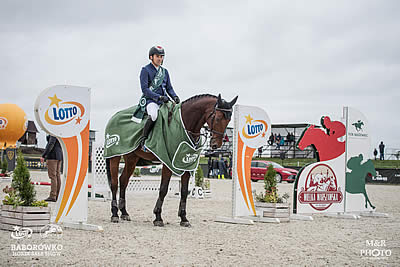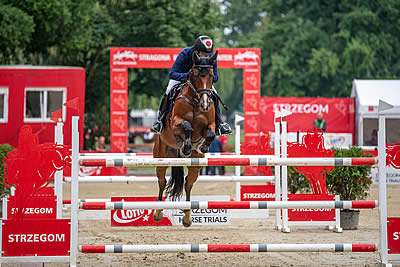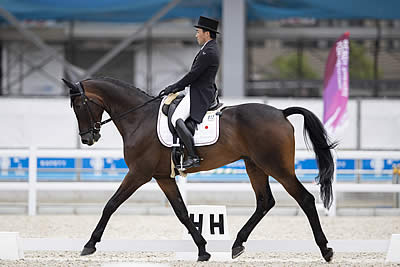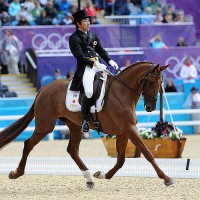Yoshiaki Oiwa riding Bart L JRA. (FEI/Yusuke Nakanishi)
Japan’s Yoshiaki Oiwa is no stranger to success, having claimed double gold at last year’s Asian Games in Jakarta (INA), and the three-time Olympian has put down a strong marker for the home side by taking the early lead after the Dressage phase at the Ready Steady Tokyo test event.
Riding the talented Bart L JRA, previously ridden by Frenchman Matthieu Lemoine on the gold medal team at the Rio 2016 Olympic Games, Oiwa earned top marks from all three judges to lead the field on a mark of 24.5. The 43-year-old has been based in Europe for almost 20 years, but his heart lies in Japan.
“I’m a home country rider and I’ve been based in Europe for the last 18, 19 years,” he said after his Dressage performance here at the Equestrian Park. “So many people are supporting and helping me, but they’ve never seen what I’m doing, so this is a very very good chance to show what I’m doing and what this sport is about. Hopefully we can do the best performance and all the Japanese people do their best and get medals.”
Among a star-studded cast, Australia’s triple Olympic team gold medalist Andrew Hoy is 3.2 penalties adrift in second with Bloom Des Hauts Crets, fractionally ahead of Germany’s double Olympic champion Michael Jung on Fischerwild Wave with 28.0.
The top five are all under 30 penalties, with Japan’s Ryuzo Kitajima and Vick Du Gisors JRA fourth on 28.2 and Germany’s Peter Thomsen with Horseware Nobleman fifth with 29.50.
Kuzuma Tomoto is another of the contingent flying the flag for Japan and he sits in sixth with Tacoma d’Horset on 30.4, a single point but three places ahead of his trainer, British legend William Fox-Pitt with Summer at Fernhill.
The Japanese athletes are increasingly a force to be reckoned with, finishing fourth and just out of the medals at last year’s FEI World Equestrian Games™ in Tryon (USA). Looking ahead to Tokyo 2020, Tomoto commented: “Our team is really tough and has got strong quickly. We’re aiming to get a medal; that’s why we have to improve more and more. We have lots of nice riders so we can do it for sure.”
Final horse into the arena, GHS Calvaruise ridden by Kazuya (JPN), has now been withdrawn after placing last of the 17 starters in Dressage on 40.8. The rest of the horses have been transported to the stables at Sea Forest where they will spend the night before cross country.
Derek Di Grazia’s 3,025 metre track incorporates 20 fences with 31 jumping efforts, but the American designer is giving nothing away about his track for the 2020 Games. Even so, the 20 National Olympic and Paralympic Committees that are onsite for the official observers programme are making the most of the opportunity to see the terrain at Sea Forest and test the facilities at both venues.
On Wednesday, action returns to the equally stunning new facilities at Baji Koen, site of the Olympic equestrian events at the 1964 Tokyo Games, for Wednesday’s final Jumping phase.
The Baji Koen refurbishment has been funded independently by the Japan Racing Association and will provide an extraordinary legacy for the residents of Tokyo, as will the park that will be created on the reclaimed land at Sea Forest, which also hosts rowing and canoe sprint next year.
Ready Steady Tokyo equestrian test event (placings after Dressage): 1, Japan’s Bart L JRA (Yoshiaki Oiwa), 24.5; 2, Australia’s Bloom Des Hauts Crets (Andrew Hoy), 27.7; 3, Germany’s Fischerwild Wave (Michael Jung), 28.0; 4, Japan’s Vick Du Gisors JRA (Ryuzo Kitajima), 28.2; 5, Germany’s Horseware Nobleman (Peter Thomsen), 29.50; 6, Japan’s Tacoma d’Horset (Kuzuma Tomoto), 30.4.
Media contacts:
Grania Willis
Director Communications
grania.willis@fei.org
+41 78 750 61 42
Shannon Gibbons
Media Relations and Communications Manager
shannon.gibbons@fei.org
+41 78 750 61 46




